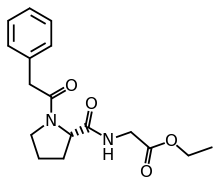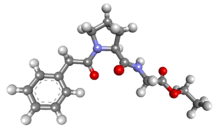N-Phenylacetyl-L-prolylglycine ethyl ester
N-Phenylacetyl-l-prolylglycine ethyl ester is promoted as a nootropic and is a prodrug of cycloprolylglycine.[1] Other names include the brand name Noopept (Russian: Ноопепт), developmental code GVS-111; proposed INN omberacetam.[1][2][3]
 | |
 | |
| Clinical data | |
|---|---|
| Trade names | Noopept |
| Other names | N-Phenylacetyl-l-prolylglycine ethyl ester; GVS-111 |
| Legal status | |
| Legal status |
|
| Identifiers | |
| |
| CAS Number | |
| PubChem CID | |
| ChemSpider | |
| CompTox Dashboard (EPA) | |
| Chemical and physical data | |
| Formula | C17H22N2O4 |
| Molar mass | 318.373 g·mol−1 |
| 3D model (JSmol) | |
| |
| |
| | |
Its synthesis was first reported in 1996.[1] It is orally available, and as of 2017 its metabolism and elimination half-life were not well understood, as cycloprolylglycine had not been measured in humans following administration.[1]
As of 2017 there had been many studies conducted in cells and in animal models, and there had been one clinical trial with 41 subjects, which compared Noopept and piracetam in people with traumatic brain injury.[1]
Pharmacology
Omberacetam modulates the acetylcholine system as well as the AMPA receptors.[4] This modulation essentially allows acetylcholine to accumulate at higher levels than that which it otherwise would. As acetylcholine is involved in the function of memory, this could potentially account for its nootropic effects. Some research also suggests that NMDA receptors are involved in omberacetam's mechanism of action.[5][6]
Legal status
- Russia: Noopept in Russia is a drug of medicine and is available without a prescription.[7]
- United Kingdom: Omberacetam is illegal to produce, supply, or import under the Psychoactive Substance Act, which came into effect on May 26, 2016.[8]
- United States: The Food and Drug Administration has issued import alerts for imports of Omberacetam, considering it an analog of piracetam. FDA considers such racetam-family substances Active Pharmaceutical Ingredients (APIs) that require new drug applications and adequate labelling before being imported.[9] Similarly, warnings have been issued for claims of medical and pharmacological effects of this officially non-drug substance.[10]
External links
References
- "Noopept Information". Examine.com. Retrieved 6 April 2017.
- "Proposed INN List 117" (PDF). WHO Drug Information. 31 (2): 308. 2017.
- "GVS 111". AdisInsight. Retrieved 12 May 2018.
- Ostrovskaia RU, Gudasheva TA, Voronina TA, Seredenin SB (September 2002). "[The original novel nootropic and neuroprotective agent noopept]". Eksperimental'naia I Klinicheskaia Farmakologiia. 65 (5): 66–72. PMID 12596521.
- Andreeva NA, Stel'mashuk EV, Isaev NK, Ostrovskaya RU, Gudasheva TA, Viktorov IV (October 2000). "Neuroprotective properties of nootropic dipeptide GVS-111 in in vitro oxygen-glucose deprivation, glutamate toxicity and oxidative stress". Bulletin of Experimental Biology and Medicine. 130 (10): 969–72. PMID 11177296.
- Kovalev GI, Vorob'ev VV, Akhmetova ER (August 1999). "NMDA component in the effects of piracetam and new nootropic peptide GVS-111 on the neocortical and hippocampal EEG in conscious rats". Bulletin of Experimental Biology and Medicine. 128 (2): 822–5. doi:10.1007/BF02433825.
- "Государственный реестр лекарственных средств".
- "Psychoactive Substances Act 2016". Legislation.gov.uk.
- "Import alert 66-66".
- "FDA Warning letter: Peak Nootropics LLC aka Advanced Nootropics".